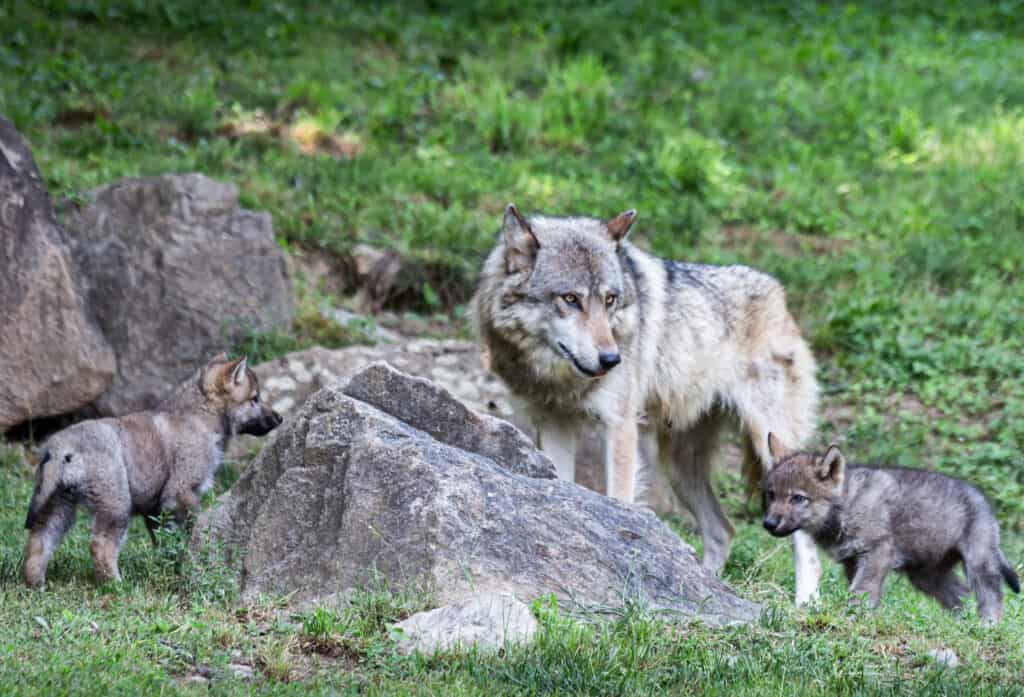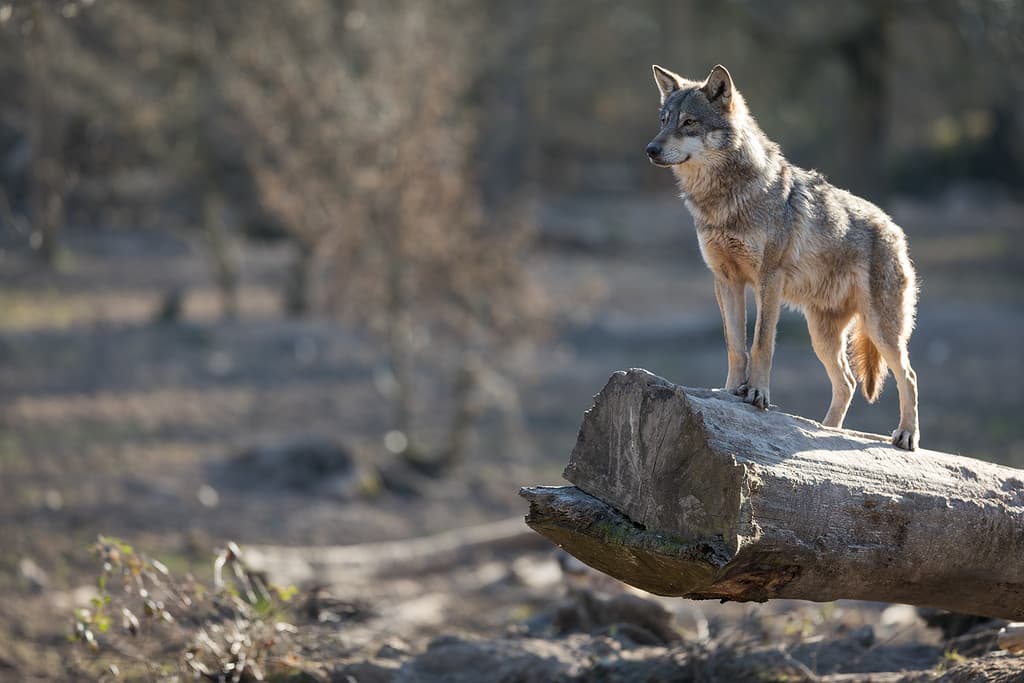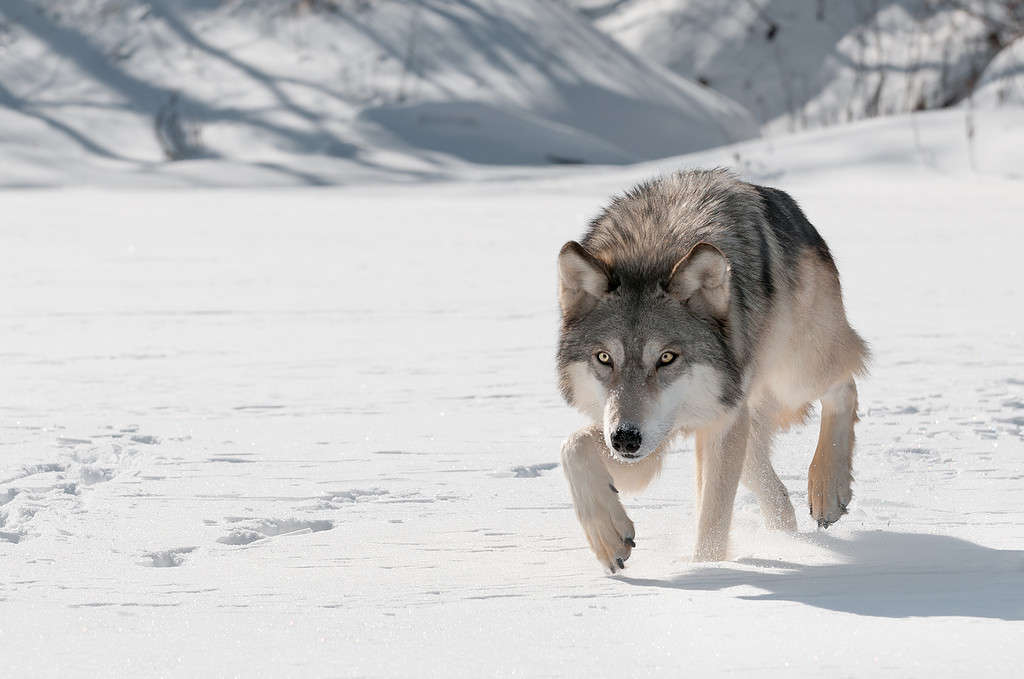Wolves are powerful apex predators that live in packs with a fascinating social hierarchy. Despite being widespread in the past, wolves were extirpated from many areas. They now inhabit thirteen states within the United States, although the majority of the country’s wolves inhabit Alaska. However, populations are gradually recovering in many areas, including Washington. So, keep reading to learn about wolves in Washington State, including where they live and what they eat.
How Many Wolves Are There in Washington State?

Washington’s wolf population is steadily increasing.
©Armelle LL/Shutterstock.com
There are currently 216 wolves in Washington State, based on the figures from the latest official wolf count in 2022. These are comprised of 37 different packs, of which 26 feature successful breeding pairs. The figures were released in April 2023, and as of yet, there are no records available from the 2023 survey.
Washington’s wolf population has been increasing for the last fourteen years. The figures from this wolf count are an increase on the previous years, which found a population of 206 wolves that were located within 33 packs and included 19 pairs of breeding animals.
Wolves remain a federally endangered species in the western two-thirds of the state but are no longer federally protected in the remaining area. However, they are still considered to be a state-endangered species across the entire area, making it illegal to kill or harass them.
Where Do Wolves Live?
Wolves are highly adaptable animals and are capable of living in a variety of habitats, although they do tend to prefer to live in forests and mountainous regions. Most of Washington’s wolves live in the north and northeastern regions of the state, although there are a small number of packs in the southern half.
Wolves were once much more widespread across the state but were extirpated from the state by the 1930s. This was largely due to human-wolf conflict and the hunting of wolves over a long period of time. However, after being absent from the state for more than 50 years, wolves returned to the state.
Wolves were never officially reintroduced to Washington but have gradually recolonized in the state, having travelled across the border from neighbouring states. By 2008, it was confirmed that there was a pack in Okanogan County and that they had successfully given birth to cubs. The number of packs and wolves has continued to grow steadily in the state since then, and their range has gradually expanded. In particular, packs have recently recolonized in the South Cascades in the winter of 2022-2023.
What Do Wolves Eat?

Wolves are powerful predators they typically prey on large mammals.
©AB Photography/ via Getty Images
Wolves are apex predators, which means that they are at the top of the food chain and have no natural predators. Their diet typically consists of large ungulates, such as moose, deer, and elk. However, if food is scarce then they will turn to smaller animals, such as rabbits, hares, and beavers.
Wolves are pack animals, and the structure of the pack is vitally important when hunting for food. By working together in a pack, wolves are much more likely to have a successful hunt than if they were working alone, particularly when they are hunting a larger animal. When it comes to hunting larger animals, the wolf pack will typically pursue the prey and then spread out to surround it before moving in for the kill.
Although wolves can be considered as having a somewhat opportunistic nature when it comes to their diet, they are actually incredibly important to the ecosystem. This is because they can keep the populations of prey animals in check. This not only helps to maintain an appropriate predator-prey balance, but it can also stop animals such as deer from over-browsing their habitat. This then allows the vegetation to recover and can prevent animals from starving. Additionally, wolves will often prey on sick and injured animals — the weakest in the herd — which keeps populations healthy and strong.
Are Wolves Dangerous?

Wolves are not usually dangerous to humans unless they are threatened in some way.
©Holly Kuchera/iStock via Getty Images
Although wolves are powerful predators, they are not typically dangerous to humans. Wolves are very shy and secretive animals and are scared of humans, much preferring to stay out of our way. There are no documented records of any wolf attacking a human in Washington State, and the risk of being attacked by one is very low. However, there are occasions when there’s a greater risk of an attack if a wolf is threatened or provoked. Therefore, if you do encounter a wolf, it’s important to remember to remain calm. Never attempt to run away as the wolf will be more likely to give chase. Instead, you should stand tall but back away slowly.
Although the risk to humans is low, wolves do sometimes prey on livestock. There are several reports of livestock predation in the state, with one ranch reporting approximately 40 animals killed by wolves in a short period of time.
Many farms already try to minimize the risk of a wolf attack by implementing measures to deter them. These include carrying out lambing and calving in barns, using lights or noise to scare away wolves, using livestock guardian animals (dogs, donkeys, alpacas), and not turning out very young calves into the pasture. However, Washington State has just recently approved a pilot scheme which allows the owner of the livestock to shoot the first wolf that returns to the site of a livestock predation without the need for a permit.
The photo featured at the top of this post is © slowmotiongli/Shutterstock.com
Thank you for reading! Have some feedback for us? Contact the AZ Animals editorial team.






